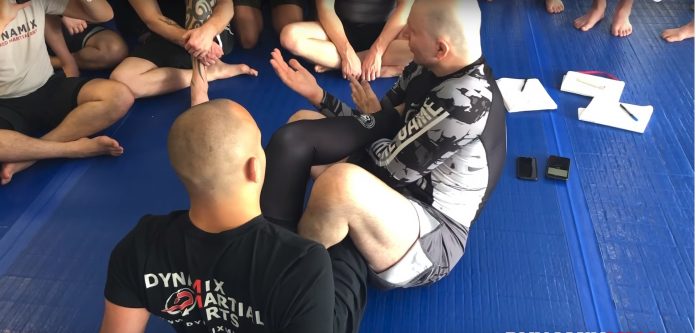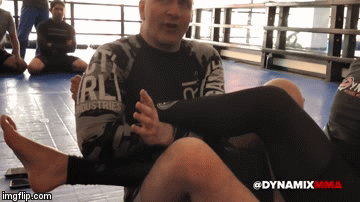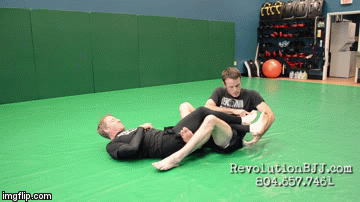
Is this leg lock legal under IBJJF rules? How about this position? To tell you the truth, I am getting sick of having to figure out answers to these two questions. It is not because the IBJJF has a restrictive set of rules. I’m ok about it and understand their reasoning. What really annoys me is the ambiguity of rules. It seems that certain leg locking positions are so complex, even the referees don’t know where to place them. After talking to a few referees I only ended up more confused about what is allowed. Of course, the Danaher Death Squad came to the rescue. Gordon Ryan recently clarified one of the top positions and how it stands with the IBJJF. And now we have the perfect and very legal BJJ foot lock from there!
There is no modern BJJ without leg locks. By now, even the most hardcore leg lock haters have accepted that fact. However, while in training anything goes, with mutual consent, of course, competition is different. It is not easy to train your leg lock game and only be allowed to use a small portion of it. If competition is your goal, then you must polish it up and play by the rules. The good news is, that this can be done. The bad news is, that you still might end up on the wrong side of a referee’s decision. And it all comes down to which BJJ foot lock you decide to use.
The trouble with organizations like the IBJJF and the UAJJF remains the same as it was even before leg locks exploded on the scene. Both organizations have probably overly elaborate rulesets that confuse even those that need to uphold them. This can make two virtually identical tournament performances have many different outcomes. While a certain BJJ foot lock might win you one tournament, it may get you DQed in the next. When you consider that both tournaments are under the same rules, you get the point I’m trying to make. The solution is a simple one – make sure you stay away from grey zones. Sounds easy in theory, but practice does prove to be more difficult.
The Issue With The Saddle Position
The main trouble with the saddle/honeyhole/4-11/Inside Senkaku position was that pesky knee reaps rule. Under IBJJF/UAJJF rules, competitors are not allowed to place their leg around an opponent’s leg from the outside in. This is considered a knee reap, which, as rules state, can lead to horrific injuries. Let’s clear that up first.
For a leg to be in a knee reap, you need to have that leg on the same side of your body as the leg that’s going around it. Think of a single leg X guard, for example. If you get the foot of your outside leg inward, you’ll get an immediate DQ. Now, go in the same position, but transfer the leg to the other (cross) side of your body. If you now get both people to the ground, you’ll see that you’re basically in a modified reverse half guard position. This position is legal for all levels under IBJJF rules. S, the saddle position, legs triangled or not, is perfectly legal to use in competition.
While this is clear, the submission options from the position are still somewhat confusing. The one thing you can’t do is attack the leg you have in a triangle. You can’t even go for a simple BJJ foot lock (not like there’s one that works anyway). Heel hooks are, of course, forbidden. If you are a brown or black belt you might try and look for kneebars, but this will sacrifice your position. So, putting it simply, the triangled leg just there for control. Any attack, even just wrapping an arm around it is an immediate DQ.
An Easy Saddle BJJ Foot Lock
The one thing you can do from the position legally is to attack the free leg. Most people nowadays tend to control the free leg anyways, so this is not too big of an adjustment. The trouble is how to successfully attack that leg. Kneebars are off the table due to the position. So are toeholds, because straightening the leg is too easy for your opponent. Plus you have no control over their hip on that side. Which leaves us with the BJJ foot lock.

For a high percentage move, you want the reverse BJJ foot lock. For this, you’ll want to thread your far side arm right under the Achilles tendon of your opponent. The closer you are to the heel, the better. Next, place a Rear Naked Choke grip on the outside of the opponent’s ankle. You’re now in complete control. Before you finish first load pressure by turning the palm of your outside arm towards you and making a fist. Now get the fist as close to your shoulder as possible. From there a simple turn of your shoulder to square up with the opponent will get the tap. Plus, you still have a lot of space to do a hip extension.
Caution And Follow-Ups

OF course, if you start to lose position or enter into a battle, you can always jump ship and go for a kneebar. Remember though, that for a kneebar, you need to attack the bottom leg. Just place it under your armpit and rotate so that your hips are in front of the opponent’s knee.
Craig Jones has the most simple and effective leg lock system available today! Check out how he gets into position to finish in his DVD instructional “Down Under Leg Attacks”. This DVD features both legal and some “darker” moves, with one common thread – effectiveness. If you know exactly what you’re can do in a competition, you can choose the perfect Craig Jones leg lock for you!
Dean Lister’s Most Lethal Legal Straight Ankle Lock Explained


![Darce Choke Encyclopedia – Origins, Mechanics and Variations [2025] BJJ, choke, Brabo, BJJ Darce Choke, D'arce Choke, Darce BJJ Choke](https://bjj-world.com/wp-content/uploads/2017/11/JungPoirierLeeYahoo-218x150.jpg)









![Countering with Crab Ride Anthony Budion DVD Review [2025] Countering with Crab Ride Anthony Budion DVD Review](https://bjj-world.com/wp-content/uploads/2025/03/countering-with-crab-ride-anthony-budion-dvd-review-218x150.png)
![Closet Closed Guard Craig Jones DVD Review [2025] Closet Closed Guard Craig Jones DVD Review](https://bjj-world.com/wp-content/uploads/2025/03/closet-closed-guard-craig-jones-dvd-review-218x150.png)
![Xanadu Back Takes Levi Jones-Leary DVD Review [2025] Xanadu Back Takes Levi Jones-Leary DVD Review](https://bjj-world.com/wp-content/uploads/2025/03/xanadu-back-takes-levi-jones-leary-dvd-review-218x150.png)

![No-Gi Grapplers Guide To Front Headlock Joel Bane DVD Review [2025] No-Gi Grapplers Guide To Front Headlock Joel Bane DVD Review](https://bjj-world.com/wp-content/uploads/2025/03/no-gi-front-headlock-joel-bane-dvd-review-218x150.png)

![360 Degrees Guard Retention Thiago Abud DVD Review [2024] 360 Degrees Guard Retention Thiago Abud DVD Review](https://bjj-world.com/wp-content/uploads/2024/10/360-degrees-guard-retention-thiago-abud-dvd-review-324x235.png)
![Neil Melanson DVD Bundle Review: Filthy Brutal No Good Attacks [2024] Neil Melanson DVD Bundle Review: Filthy Brutal No Good Attacks](https://bjj-world.com/wp-content/uploads/2024/10/neil-melanson-dvd-bundle-review-filthy-attacks-100x70.png)

![Unpinnable Mount Escape Mastery Haleem Syed DVD Review [2025] Mount Escape Mastery Haleem Syed DVD Review](https://bjj-world.com/wp-content/uploads/2025/01/mount-escape-mastery-haleem-syed-dvd-review-100x70.png)

![Two Sides One Game Sweep and Pass Marcos Tinoco DVD Review [2024] Two Sides One Game Sweep and Pass Marcos Tinoco DVD Review](https://bjj-world.com/wp-content/uploads/2024/11/sweep-and-pass-marcos-tinoco-dvd-review-100x70.png)
![Closed Guard Reintroduced Adam Wardzinski DVD Review [2025] Closed Guard Reintroduced Adam Wardzinski DVD Review](https://bjj-world.com/wp-content/uploads/2025/01/closed-guard-reintroduced-adam-wardzinski-dvd-review-100x70.png)



![A Blueprint For Smeshing Khabib Nurmagomedov DVD Review [2024] A Blueprint For Smeshing Khabib Nurmagomedov DVD Review](https://bjj-world.com/wp-content/uploads/2024/10/blueprint-for-smeshing-khabib-nurmagomedov-dvd-review-100x70.png)
![Back Hacks Yigit Haney BJJ DVD Review [2025] Back Hacks Yigit Haney BJJ DVD Review](https://bjj-world.com/wp-content/uploads/2024/12/back-hacks-yigit-haney-bjj-dvd-review-100x70.png)
![Zen Guide To Submission Grappling Margot Ciccarelli DVD Review [2025] Zen Guide To Submission Grappling Margot Ciccarelli DVD Review](https://bjj-world.com/wp-content/uploads/2025/02/submission-grappling-margot-ciccarelli-dvd-preview-100x70.png)
![Trip Throw Dilemma Michael Pixley and Heath Pedigo DVD Review [2024] Trip Throw Dilemma Michael Pixley and Heath Pedigo DVD Review](https://bjj-world.com/wp-content/uploads/2024/10/trip-throw-dilemma-michael-pixley-dvd-review-100x70.png)
![Basic Closed Guard Jasmine Rocha DVD Review [2024] Basic Closed Guard Jasmine Rocha DVD Review](https://bjj-world.com/wp-content/uploads/2024/11/basic-closed-guard-jasmine-rocha-dvd-review-100x70.png)

![Crossing and Spinning Steps To Attack Israel Hernandez DVD Review [2024] Crossing and Spinning Steps To Attack Israel Hernandez DVD Review](https://bjj-world.com/wp-content/uploads/2024/09/spinning-steps-to-attack-israel-hernandez-dvd-review-100x70.png)

![Closet Closed Guard Craig Jones DVD Review [2025] Closet Closed Guard Craig Jones DVD Review](https://bjj-world.com/wp-content/uploads/2025/03/closet-closed-guard-craig-jones-dvd-review-100x70.png)
![Feet Finder Foot Sweeps Christian Ozbek DVD Review [2024] Feet Finder Foot Sweeps Christian Ozbek DVD Review](https://bjj-world.com/wp-content/uploads/2024/09/feet-finder-foot-sweeps-christian-ozbek-dvd-review-100x70.png)
![Crush The Guard Vagner Rocha DVD Review [2024] Crush The Guard Vagner Rocha DVD Review](https://bjj-world.com/wp-content/uploads/2024/10/crush-the-guard-vagner-rocha-dvd-review-100x70.png)

![Darragh O’Conaill Crucifix Encyclopedia DVD Review [2024] Darragh O'Conaill Crucifix Encyclopedia DVD Review](https://bjj-world.com/wp-content/uploads/2024/10/darragh-oconaill-crucifix-encyclopedia-dvd-review-100x70.png)
![Baseball Chokes From Everywhere Magid Hage DVD Review [2025] Baseball Chokes From Everywhere Magid Hage DVD Review](https://bjj-world.com/wp-content/uploads/2025/01/baseball-chokes-from-everywhere-magid-hage-dvd-review-100x70.png)


![Breaking Their Guard Mikey Musumeci DVD Review [2025] Breaking Their Guard Mikey Musumeci DVD Review](https://bjj-world.com/wp-content/uploads/2025/02/breaking-their-guard-mikey-musumeci-dvd-review-100x70.png)

